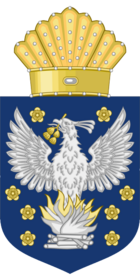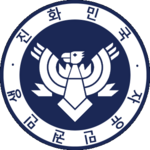Emperor Seongjo of Zhenia
This article is incomplete because it is pending further input from participants, or it is a work-in-progress by one author. Please comment on this article's talk page to share your input, comments and questions. Note: To contribute to this article, you may need to seek help from the author(s) of this page. |
| Li Zichuan | |||||||||||||
|---|---|---|---|---|---|---|---|---|---|---|---|---|---|
| Emperor of Zhenia Khagan of the Yemeg and Balakhaat People | |||||||||||||
 Portrait in 1877. | |||||||||||||
| Emperor of Zhenia, Khagan of the Yemeg and Balakhaat people | April 15, 1844 - October 27, 1867 (as Emperor of Shindan) August 1, 1847 - November 26, 1889 (as Khagan of the Yemeg and Balakhaat People) October 27, 1867 - November 26, 1889 (as Emperor of Zhenia) | ||||||||||||
| Coronation | April 15, 1844 | ||||||||||||
| Predecessor | Emperor Jeongjo | ||||||||||||
| Successor | Emperor Saejo | ||||||||||||
| Born | Li Zichuan (李自淸; 이자청) June 4, 1827 Jeonju, Anam Province, Shindan | ||||||||||||
| Died | 26 November 1889 (aged 62) Daedo, Empire of Zhenia | ||||||||||||
| Burial | |||||||||||||
| Empress | Empress Soyang | ||||||||||||
| |||||||||||||
| House | Imperial House of Li | ||||||||||||
| Father | Emperor Jeongjo (정조황제) | ||||||||||||
| Mother | Empress Goryun (고륜황후) | ||||||||||||
| Religion | Zhenian Wuism | ||||||||||||
Part of a series on the |
|---|
| History of Zhenia |
 |
| Timeline |
Emperor Seongjo of Zhenia (Classic Zhenian: 聖祖, Modern Zhenian: 대동진제국 성조황제), alternately referred to as Emperor Seongjo of Shindan or his personal name Li Zichuan (Classic Zhenian: 李自淸, Modern Zhenian: 이자청), was the founder and emperor of the Empire of Zhenia, as well as the last emperor of Shindan, reigning from 1844 to his death in 1905. His rule saw the unification of Zhenia through the Zhenian Civil War, as well as the rapid transformation of Shindan from a feudal hermit state to an industrialized power, as well as the transformation of Zhenia from a decentralized state into an industrialized world power.
Shindan and later Zhenia saw profound changes during his rule - while the Shindan dynasty remained a pre-industrial, isolated nation heavily influenced by consort clans before his rule, the Empire of Zhenia had undergone significant political, military, economic and cultural forms and had become an industrialized power by his death in 1889. Credited for such profound changes, Emperor Seongjo is widely regarded as the "father of modern Zhenia" as well as the "last pre-modern leader of pre-modern Zhenia".
Early Life
Emperor Seongjo was born with the name Li Zichuan on June 4, 1827, as an illegitimate second son of King Jeongjo, in the port city of Jeonju, Honam Province. Having spent his early years near the port, Li Zichuan made contact with the Auroran and Southeast Tarsic missionaries and traders, from whom he gained insight into what had been going on outside the Danguk peninsula. At age 7, he became one of the first 20 students to have enrolled in the Jeonju Shinhak Academy, one of the first primary and secondary institutions in the nation to have been established by an Auroran missionary, although the Royal House relocated him to Sanggyeong two years later, fearing that education from Auroran missionaries would prove to be a bad influence to the prince.
With the early death of his brother and the deposition of King Jeongjo's only legitimate son in 1841, Li Zichuan was selected as the crown prince of Shindan, with no other candidates among the direct descendants of the King. His coronation occurred on April 15, 1844.
As King of the Shindan dynasty
Directly after his coronation in 1844, Li Zichuan vowed that the Shindan would end its vassal position with the Empire of Greater Wu, following a series of petitions calling for the Shindan to become an empire and stand even against the Greater Wu. Although his declaration was met with explicit dissent from the Wu, Li Zichuan responded firmly, calling for the preparation of war against the Greater Wu. Under his leadership, the Shindan nationalized the assets of regional aristocrats and its rare-earth mines to acquire the funds needed for war, while also calling for the collection of militiamen nationwide. In addition to domestic preparations, with the assistance from envoys of the kingdoms of Husgratin and Zonnenbord, Li Zichuan was able to leverage both diplomatic assistance and the acquisition of Auroran weaponry from the two Auroran kingdoms, in exchange of the opening of three additional trading ports to the Aurorans, freedom of religion inside Shindan and the establishment of embassies of the respective nations in Shindan.
Upon initiation of the war in November 1846, Li Zichuan broke the tradition of the Shindanese royal refuge by temporarily relocating the capital to Sanggyeong, rather than moving to the Haedong Islands, while he led the Royal Guards in the war himself. Following a series of decisive victories against the Greater Wu, the Shindan had forced the retreat of the Greater Wu forces further away from the original border, ultimately flanking Seoggyeong by July 1847. The Second Shindan-Wu War, under his leadership, ended with the Treaty of Sanggyeong, shifting the borders of the Shindan further west and bringing the Shindan under a personal union with the Yemeg-Balakhaat Empire. It was after the Treaty of Sanggyeong that Li Zichuan also ruled as Khagan of the Yemeg-Balakhaat Empire, a position he had retained until his death.
While the modernization of the Shindan dynasty accelerated after the victory of the Second Shindan-Wu War, Li Zichuan declared the complete emancipation of slaves in the Shindan dynasty and pushed for nationwide reforms on land ownership, focusing on boosting tax revenue and compensated purchases and distribution of land among all Shindanese peasants throughout the nation in terms of land ownership. The same year, he also became the first Shindanese leader to have cut his topknot before the Royal Court and adopt western clothing in the government, effectively silencing all dissent regarding the administrative order banning topknots. Modernization of the Shindan dynasty also became noticeable during subsequent years of his rule, as the first Zhenian legal system specifying a modern version of conscription but excluding collective punishment was introduced, while the military was also restructured to modern standards with input from Auroran military advisers.
In October 1850, central and western warlords in the Empire of Greater Wu declared secession from the empire amid record levels of drought and famine, claiming that the Mandate of Heaven was now gone; Li Zichuan seized the opportunity to bring an end to the Empire of Greater Wu, which was now reduced to a regional state that only controlled the Junggyeong area, with the invasion initiating in February 1851. With little to no resistance from Greater Wu forces, the Empire of Greater Wu surrendered to the Shindan dynasty, being degraded to the Kingdom of Wu, a vassal state of the Shindan dynasty. Amid such circumstances, Li Zichuan's coronation as the Emperor of the Shindan dynasty and the subsequent elevation of the Shindan into an empire was held in February 16, 1851.
During the Zhenian Civil War
Following the collapse of the Empire of Greater Wu, Li Zichuan announced a new feudal system across the former territories of the Greater Wu, consisting of smaller kingdoms scattered throughout mainland Zhenia centered around the Shindan dynasty, while the formal name of the Shindan dynasty was raised into the Empire of Shindan.
Under the Empire of Zhenia
Daeseong Reforms
Shinzhen Doctrine
Final Years
Legacy
Emperor Seongjo is regarded as the "father of modern Zhenia" alongside Amasar Ren, for his accomplishments of the reunification of Zhenia and the modernization of both the Shindan dynasty and the Empire of Zhenia. He is also simultaneously considered the "last pre-modern ruler of Zhenia", due to his authoritarian methods during the enlightenment of Zhenia.
